
A daylily or day lily is a flowering plant in the genus Hemerocallis, a member of the family Asphodelaceae, subfamily Hemerocallidoideae. Despite the common name, it is not in fact a lily. Gardening enthusiasts and horticulturists have long bred daylily species for their attractive flowers. Thousands of cultivars have been registered by local and international Hemerocallis societies. Daylilies are perennial plants, whose name alludes to its flowers, which typically last about a day.

Delphinium is a genus of about 300 species of annual and perennial flowering plants in the family Ranunculaceae, native throughout the Northern Hemisphere and also on the high mountains of tropical Africa. The genus was erected by Carl Linnaeus.

Anemonoides nemorosa, the wood anemone, is an early-spring flowering plant in the buttercup family Ranunculaceae, native to Europe. Other common names include windflower, European thimbleweed, and smell fox, an allusion to the musky smell of the leaves. It is a perennial herbaceous plant growing 5–15 cm (2–6 in) tall.
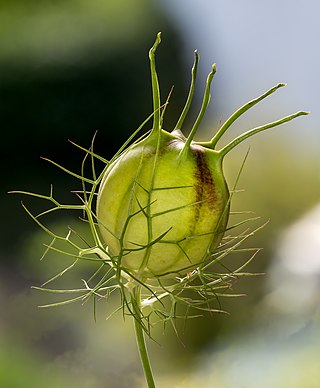
Nigella is a genus of 18 species of annual plants in the family Ranunculaceae, native to Southern Europe, North Africa, South Asia, Southwest Asia and Middle East. Common names applied to members of this genus are nigella, devil-in-a-bush or love-in-a-mist.
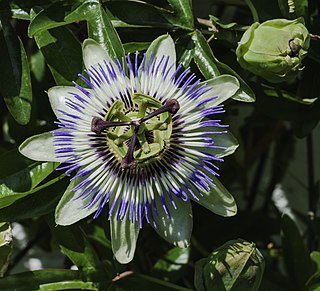
Passiflora caerulea, the blue passionflower, bluecrown passionflower or common passion flower, is a species of flowering plant native to South America. It has been introduced elsewhere. It is a vigorous, deciduous or semi-evergreen tendril vine growing to 10 m (33 ft) or more. Its leaves are palmate, and its fragrant flowers are blue-white with a prominent fringe of coronal filaments in bands of blue, white,yellow, and brown. The ovoid orange fruit, growing to 6 cm (2 in), is edible, but is variously described as having a bland, undesirable, or insipid taste. In South America, the plant is known for its medicinal properties, and is used by both the Toba and the Maka peoples.

Hyacinthus orientalis, the common hyacinth, garden hyacinth or Dutch hyacinth, is a species of flowering plant in the family Asparagaceae, subfamily Scilloideae, native to southwestern Asia, southern and central Turkey, northwestern Syria, Lebanon and northern Israel. It was introduced to Europe in the 16th century. It is widely cultivated everywhere in the temperate world for its strongly fragrant flowers which appear exceptionally early in the season, and frequently forced to flower at Christmas time.

Thalictrum is a genus of 120-200 species of herbaceous perennial flowering plants in the buttercup family, Ranunculaceae, native mostly to temperate regions. Meadow-rue is a common name for plants in this genus.

Wisteria floribunda, common name Japanese wisteria, is a species of flowering plant in the family Fabaceae, native to Japan. Growing to 9 m (30 ft), Wisteria floribunda is a woody, deciduous twining climber. It was first brought from Japan to the United States in the 1830s. Since then, it has become one of the most highly romanticized flowering garden plants. It is also a common subject for bonsai, along with Wisteria sinensis.

Nigella sativa is an annual flowering plant in the family Ranunculaceae, native to eastern Europe and Western Asia, but naturalized over a much wider area, including parts of Europe, northern Africa and east to Myanmar. It is used as a spice in many cuisines.

Lomelosia caucasica, the Caucasian pincushion flower, pincushion-flower or Caucasian scabious, is a species of flowering plant in the family Caprifoliaceae, native to the Caucasus, north eastern Turkey, and northern Iran. Growing to 60 cm (24 in) tall and broad, it is a clump-forming perennial with grey-green, divided leaves. Pincushion-shaped buds, borne on erect hairy, stems, open to pale blue or lavender flower heads, 4–8 cm (2–3 in) in diameter, from late summer through to autumn.
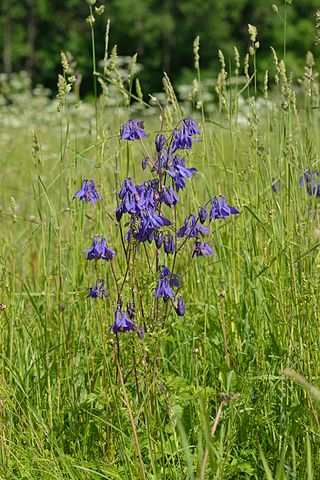
Aquilegia vulgaris is a species of columbine native to Europe with common names that include: European columbine, common columbine, granny's nightcap, and granny's bonnet. It is a flowering herbaceous perennial plant growing to 1.2 m tall, with branched, thinly hairy stems. The leaves are biternate; each leaf has three groups of three leaflets. The flowers, in various shades of purple, blue, pink and white, are pendent or horizontal with strongly hooked spurs, and appear in early summer.

Lavandula angustifolia, formerly L. officinalis, is a flowering plant in the family Lamiaceae, native to the Mediterranean. Its common names include lavender, true lavender and English lavender ; also garden lavender, common lavender and narrow-leaved lavender.
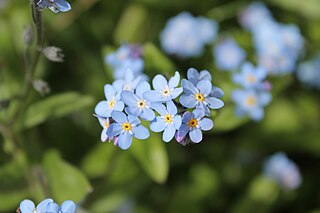
Myosotis sylvatica, the wood forget-me-not or woodland forget-me-not, is a species of flowering plant in the family Boraginaceae, native to Europe. This spring-flowering plant and its cultivars, typically with blue flowers, are the familiar forget-me-nots of gardens.
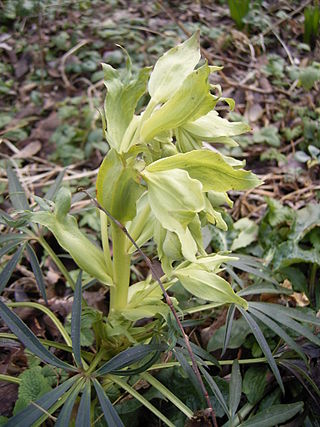
Helleborus foetidus, known variously as stinking hellebore, dungwort, setterwort and bear's foot, is a species of flowering plant in the buttercup family Ranunculaceae, native to the mountainous regions of Central and Southern Europe and Asia Minor. It is found wild in many parts of England, especially on limestone soil.

Kalmia angustifolia is a flowering shrub in the family Ericaceae, commonly known as sheep laurel. It is distributed in eastern North America from Ontario and Quebec south to Virginia. It grows commonly in dry habitats in the boreal forest, and may become dominant over large areas after fire or logging. Like many plant species of infertile habitats it has evergreen leaves and mycorrhizal associations with fungi. It is also found in drier area of peat bogs.

Lobelia erinus is a species of flowering plant in the bellflower family Campanulaceae, native to southern Africa.

Salvia greggii, the autumn sage, is a herbaceous perennial plant native to a long, narrow area from southwest Texas, through the Chihuahuan Desert and into the Mexican state of San Luis Potosi, typically growing in rocky soils at elevations from 5,000 to 9,000 ft. It was named and described in 1870 by botanist Asa Gray after Josiah Gregg, a merchant, explorer, naturalist, and author from the American Southwest and Northern Mexico, who found and collected the plant in Texas. It is closely related to, and frequently hybridizes with, Salvia microphylla. Despite the common name "autumn sage", it blooms throughout the summer and autumn.

Phlox paniculata is a species of flowering plant in the phlox family (Polemoniaceae). It is native to parts of the eastern and central United States. It is extensively cultivated in temperate regions as an ornamental plant and has become established in the wild in scattered locales in other regions. Common names include fall phlox, garden phlox, perennial phlox, summer phlox, and panicled phlox.
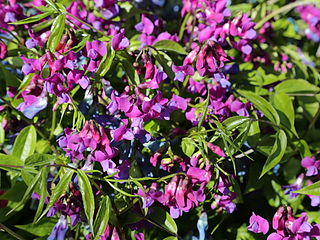
Lathyrus vernus, the spring vetchling, spring pea, or spring vetch, is a species of flowering herbaceous perennial plant in the genus Lathyrus, native to forests of Europe and Siberia. It forms a dense clump of pointed leaves with purple flowers in spring, shading to a greenish-blue with age.
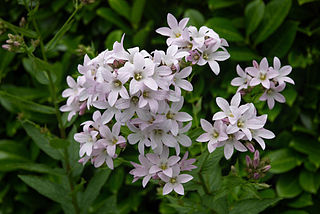
Campanula lactiflora, the milky bellflower, is a species of flowering plant in the genus Campanula of the family Campanulaceae, native to Turkey and the Caucasus. It is a medium-sized herbaceous perennial growing to 1.2 m, with narrow, toothed leaves 5–12 cm (2–5 in) long. Large conical clusters of open, star-shaped flowers are produced on branching stems in summer. In favourable conditions it will self-seed with variable results. The flowers are usually white or pale blue, but numerous cultivars have been developed for garden use, in a range of colours.


























